Chris Holtmann’s January Woes, By The Numbers
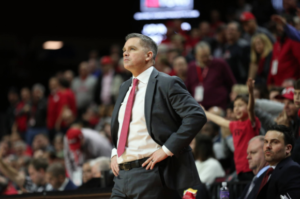
Ohio State’s struggles on the basketball court in recent weeks have been well-documented. The Buckeyes, after an outstanding 11-2 start that saw ranked wins over Villanova, North Carolina and Kentucky, have fallen apart in January.
A loss to West Virginia on Dec. 29 may have served as a canary in the mines for what has become a disastrous January, with Ohio State falling to four of five opponents in the month, all of which came in conference play. That outstanding start yielded a strong record that, entering the most important stretch of the season, means essentially nothing.
Ohio State sits at 2-5 in the Big Ten, which should be enough, regardless of finish, to eliminate it from conference title contention and a top spot in either the NCAA or Big Ten tournaments. The Buckeye season has not ended, and 12-6 at this point in the season is not a death knell, but the sudden struggles have been gut wrenching for head coach Chris Holtmann and his young team, though it doesn’t come entirely as a shock.
“Some of it were concerns we had going into the season about were we going to take the next step in terms of our efficiency offensively, in particular our perimeters,” Holtmann said. “So it’s not a complete surprise to me. I thought we had made some improvements. Obviously we’ve got to do a better job coaching them to make sure we are making improvements. At the end of the day, listen, it’s not going to change until we make some of these real changes, and that’s the bottom line.”
Given a look at Ohio State’s roster, the struggles make sense. It’s a talented group, but a group without a true top dog. Kaleb Wesson leads the team with 14.7 points per game, but plays a style of basketball that doesn’t lend itself to consistent outbursts of big point totals.
Second in line is guard Duane Washington with 11.3 points per game, and the sophomore has spent a lot of this month in Holtmann’s doghouse, which culminated in a benching against Indiana, and suspension a game later against Nebraska.
Less relevant than the current roster, but still worth noting is Ohio State’s recent history. This is not uncharted territory for the Buckeyes, who experienced almost the exact same scenario in 2018-2019, starting off 12-1 before rattling off a paltry 1-6 January. If the saying “hitting the freshman wall” is true, it may be happening to Ohio State’s entire team, freshman or not, for the second straight season.
“I think, sure, there are some similarities,” Holtmann said. “Young guys struggling through January. A little bit of injury issues. I’m sure there are some similarities. I’ve not spent a whole lot of time kind of looking at the two. But, yeah, I’m sure there are some similarities.”
Interestingly enough, this isn’t only a budding trend for Ohio State: It’s problem that Holtmann has faced for essentially all of his nine year career as a head coach.
Since taking over at Gardner-Webb in 2010, Holtmann has an impressive 70.5% win percentage in games prior to January, a figure that would be even higher (81.8% pre-Jan. at Butler and Ohio State) were it not for early struggles at Gardner-Webb.
Just as Ohio State has experienced in recent years however, there’s a severe drop-off when the calendar changes over. In January, Holtmann has just a 44.3% win percentage (50.9% at Butler and OSU). Now, there is a post-January bounce back, with the win percentage bumping up to 54.9% after some stabilization (59.1% at Butler and OSU).
That’s stark. That’s significant enough that it probably can’t be explained away with “bad luck” or too small a sample size, given that Holtmann has coached 286 games over this period. That’s long enough for a trend to develop, and January struggles certainly seem to be an issue for the 48-year-old head coach.
There are some exceptions, like in 2017, when Ohio State actually improved its win percentage significantly in January, jumping from 73.3% pre-Jan. to 88.9% in January, only to come back down to 60% in the final stretch.
That January improvement is the exception, not the rule. Only one other time, in 2014-2015, Holtmann’s first season at Butler, was there a season with that jump, and then it was only a little more than a three point difference between the start of the season (71.4%) and January (75%) win percentages.
Usually, with things like this, an obvious cause can be identified, and the one that would make the most sense is age. Ohio State was very young last season and is just about the same this season, and young players not being able to adjust to the rigors of college basketball would make sense.
However. the correlation between weighted team experience (as tracked by Sports Reference) and those January struggles is almost none, with a 0.139 indicating almost no relationship between the two (the closer to one -positive or negative- the stronger the correlation).
Age could still be an issue, but there’s nothing that indicates that it’s the issue. Holtmann’s most experienced team, Butler in 2015-2016, fell from an 84.6% winning percentage before January to 37.5% in January.
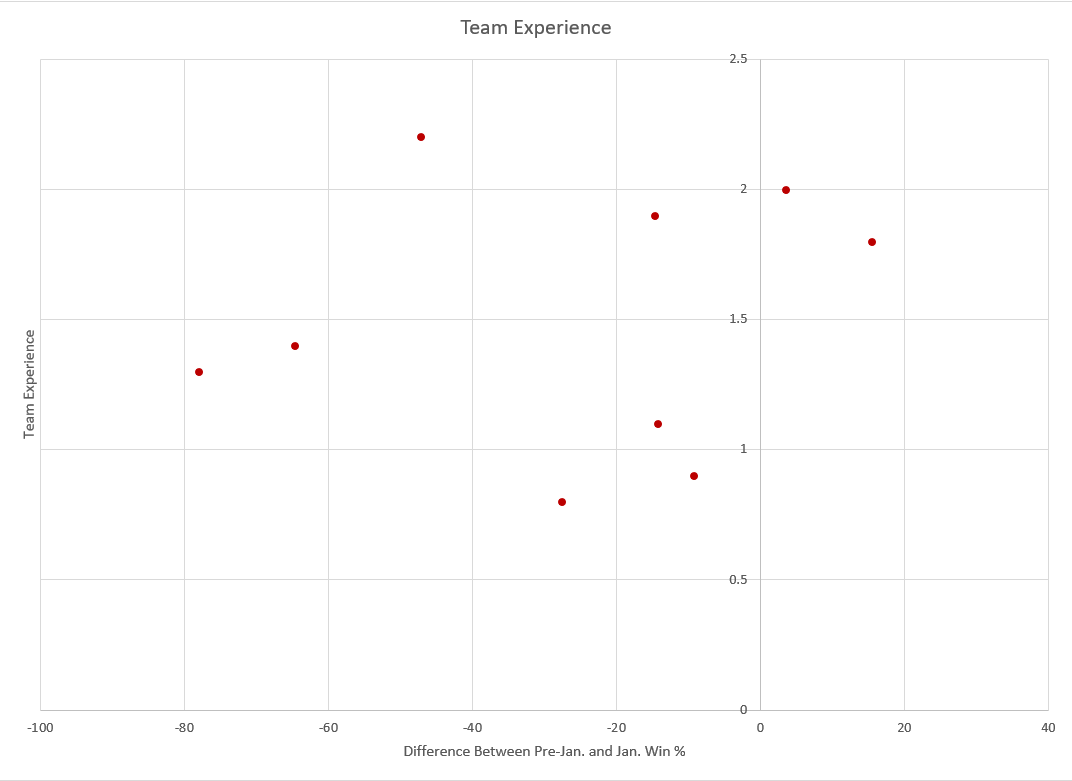
As one would expect, there is a direct correlation between those win percentage drops and in crucial team statistics. Those January craters tell the story of teams that aren’t just getting unlucky, but teams that are experiencing a complete failure in essentially every major part of the game. Firstly, points per game against opponent points per game, the simplest and most important stats in basketball.
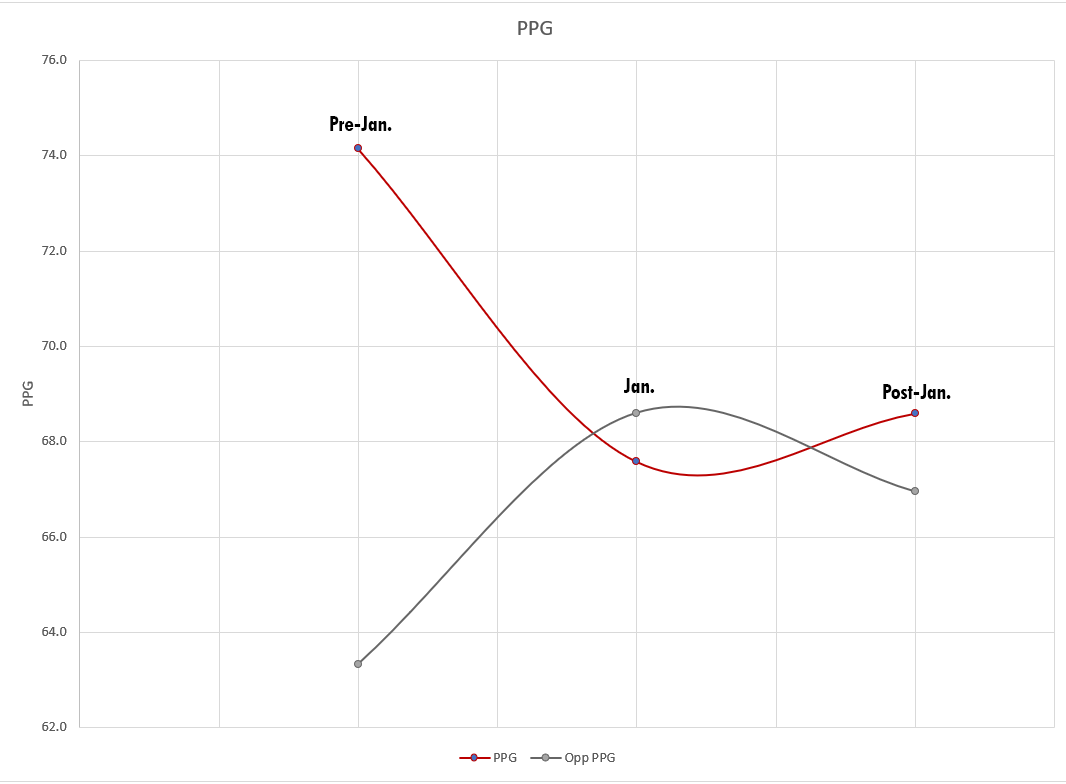
The depressed point totals for Holtmann teams can be explained, at least in part, by the next graph: field goal percentage, and its relationship to win percentage.
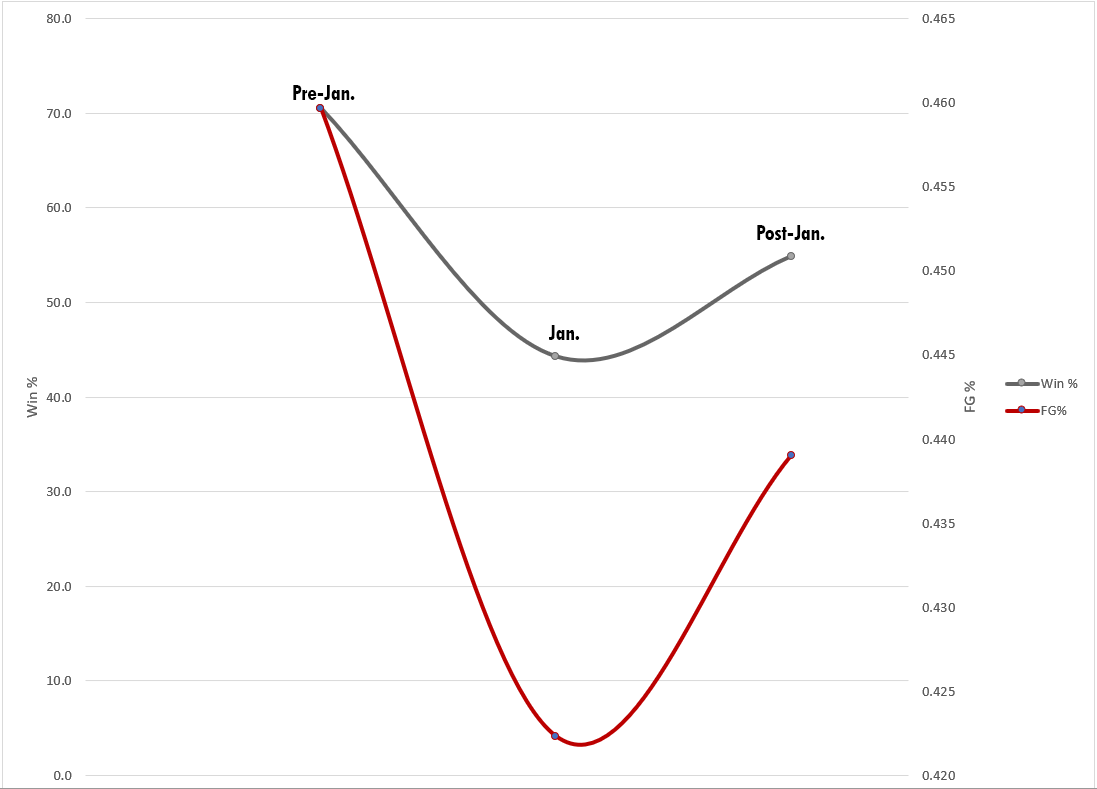
To read: Win % on left axis, represented by gray line. FG% on right axis, represented by red line.
Tangibly, the decrease in field goal percentage is yielding about two fewer made shots a game (26.2 to 23.8), which, when paired with about one fewer three pointer (19.9 to 19.1) and one fewer free throw (14.7 to 13.7), the nearly seven point difference between Holtmann’s points per game (74.1) before January and points per game in January (67.8).
Most notable might be the final graph, which shows a rapid decrease in assist numbers when those slumps set in. Raw assist numbers are far from perfect, but when they’re low, it’s a pretty good sign that an offense isn’t doing much to create easy shots. When paired with far better numbers from early in a season, it can either indicate fatigue or the setting in of some sloppiness.
Interestingly enough, turnover numbers don’t see a significant increase during this time, though that could also be due to a lack of passes that could actually lead to a turnover.
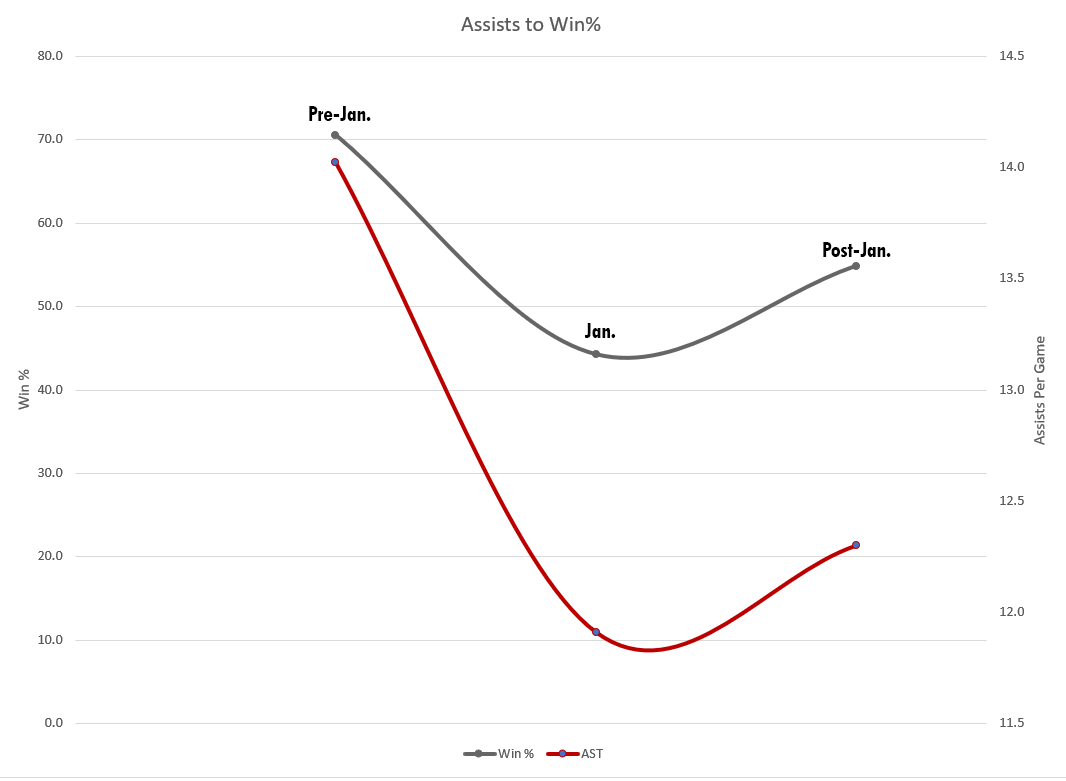
To read: Win % on left axis, represented by gray line. Assists per game on right axis, represented by red line.
All of this paints a pretty bleak picture. Ohio State’s production is down in almost every category, with the losses piling up quicker than the Buckeyes can dig themselves out. On top of that, history is not with the Buckeyes that they’ll be able to pull it together before finishing out the month against Minnesota on Jan. 23 and Northwestern on Jan. 26.
The good news is that the stats do indicate an eventual recovery. Holtmann will likely make some changes, and Ohio State could look to return to around the middle of the pack in the Big Ten, because while it isn’t a contender, this is not a Big Ten bottom feeder level roster, and these sorts of things have a way of leveling out.
Until then, however, Ohio State has some reflection to do, and that could bring with it a few more tough losses.
“Listen, it won’t change until we change some of these things,” Holtmann said. “That’s on all of us. It’s not going to change until we play smarter and tougher and sounder in a lot of ways.”
For four free issues of the weekly print edition of Buckeye Sports Bulletin, no card required, sign up at the link here: http://www.buckeyesports.com/subscribe-4issue-trial/